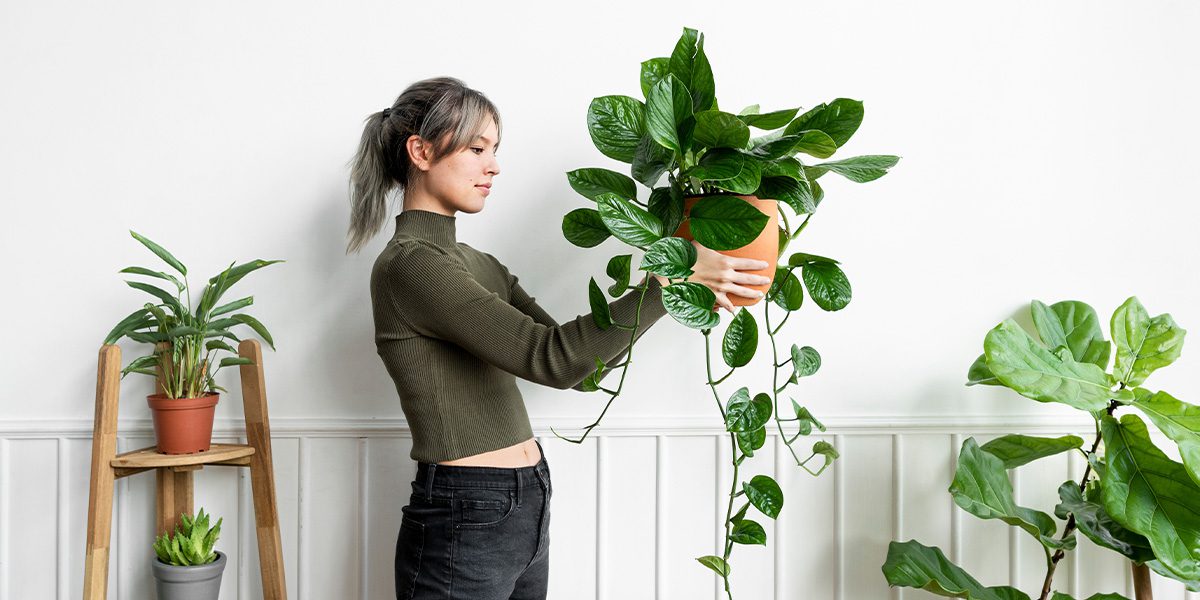As the seasons change, our fall houseplant care has to adjust as well.
With a proactive approach, we can ensure our vacationing houseplants have a smooth transition indoors.
Fall houseplant care is an essential element of being a plant parent—if you brought them outside this summer, they probably appreciated the chance to bask in the rays and breathe the fresh air. Now that the fall is here, it’s time to bring them back inside, but the good times can continue indoors. The key is to give them the right care so they have an easy transition and feel right at home in their new environment. Everyone benefits from a holiday every now and again, even our beloved indoor plants!

Assessing Your Houseplant
If you are a plant living outdoors, it’s natural that you’d offer some of your leaves and branches for a few insects. But these tiny friends won’t serve us or the houseplants indoors and could proliferate into pests without any natural predators. So, before relocating your houseplants, carefully examine them for tiny insects like aphids and spider mites. You can remove these pests by hand, use an all-natural insecticidal soap, or give the plants a thorough rinse with water.
Trim and Repot as Necessary
If your houseplants have let their hair down a bit during the summer, the fall may be a good time for pruning and repotting. If pruning is in order, trim no more than one-third of the plant’s growth. In the case of repotting, choose a pot that’s one size, or approximately one-to-two inches larger than its current container. Giving them fresh potting mix can also help eliminate any unwanted insects. Plus, it’s an opportunity to refresh your houseplants with new potting mix for the coming winter and following year!
Gradual Acclimatization
For plants, moving can be a stressful time. They’ve oriented themselves to the particular angle of sunlight, temperatures, and humidity levels outside. Now we go and move them to a totally different place. That’s not exactly normal for creatures who are used to having their roots in one place their whole lives.
To prevent shock, take care to give them a gradual transition inside. Most houseplants can’t withstand temperatures below 45°F, so plan to start their move well in advance of cold weather. Like the opposite of hardening off, begin by bringing the houseplants into a shadier spot to help them adjust to lower light. Over the following week, let them spend some time indoors for a few afternoons before moving them permanently to their new location.
Indoor Houseplant Climates in Illinois
As you transition houseplants indoors this fall, make sure to give them the right environment. A spot with proper sunlight is essential for fall and winter care. If you forget what your houseplants need, do some research or feel free to visit our Garden Centers. Keep in mind that the sun in Northern Illinois is weaker and more slanted during the winter months. And, like always, observe your plant for signs of leaning or sunburn, and adjust their proximity to the window as needed.
Adjusting Watering Routine
Just as our thirst levels differ on hot summer afternoons versus a fall day working inside, a houseplant’s water needs also change. In fact, even houseplants that remain inside all year need different water care during the winter months. Most houseplants go dormant, meaning their growth slows and water uptake goes down. At the same time, your furnace can dry the climate inside, adding an extra complication.
The solution? Pay careful attention to your plants during the fall transition and adjust your watering schedule as needed. Instead of following a regular routine, probe the soil with your finger before watering to ensure they need it. Since winter is a period of rest for houseplants, they won’t need fertilizer during this time either.
You can also let the plant wilt a little before watering just to get a better sense of how much water they really need. This practice can be helpful in periods of adjustment, like the fall, but not as a constant in the long term.
Storing Tender Bulbs
You don’t have to say goodbye to your tender bulbs over the winter. With the right care, you can dig them up in the fall and store them inside until next spring. This applies to bulbs such as dahlias, canna lilies, and elephant ears, among others. How to do it? Here are the steps:
- When the foliage turns yellow in the fall, trim away the leaves and carefully dig up your bulbs. Note: it’s important to leave a bit of stem on the tubers for plants like dahlias. They will not regrow if the whole stem is removed.
- Gently brush off any soil, and let them dry in a well-ventilated shaded area for a few days.
- Carefully inspect bulbs and discard any dead, diseased, or injured parts, as these won’t keep over the winter.
- Individually wrap the bulbs in newspaper or cover them all with sphagnum moss, vermiculite, or sawdust to help them retain some moisture.
- Store them in a cool, dry, dark place in a cardboard box with temperatures around 50-55°F.
- Periodically check on the bulbs throughout the winter to remove any that may have shriveled, or you detect any signs of rot or mold.
As the seasons change, our fall houseplant care has to adjust as well. With a proactive approach, we can ensure our vacationing houseplants have a smooth transition indoors. Plus, we are ready to give all our houseplants a cozy climate to thrive and rest during the off-season. As always, if you have any more houseplant questions, feel free to visit us at our Garden Center’s Bloomingdale and Carpentersville!
Platt Hill Nursery is Chicago’s premier garden center and nursery.




